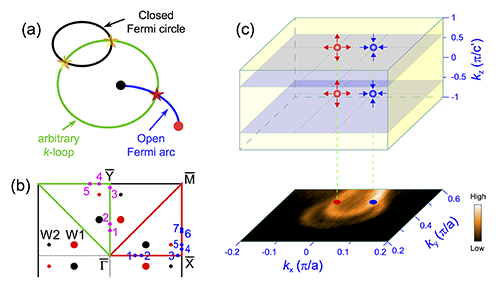Experimental discovery of Weyl semimetal TaAs
Date:24-09-2015 Print
Abstract
DING Hong’s group at the Institute of Physics, Chinese Academy of Sciences has discovered experimentally the Weyl semimetal state in TaAs by direct observation of surface Fermi arcs and bulk Weyl nodes using angle-resolved photoemission spectroscopy.
Key word:Weyl semimetal; Weyl fermion; Weyl node; Fermi arc
Contact:
Institute of Physics, Chinese Academy of Sciences
DING Hong Email: dingh@iphy.ac.cn
In 1929, H. Weyl proposed that the massless solution of the Dirac equation represents a pair of chiral particles, later named as Weyl fermions. However, Weyl fermionas a fundamental particle remains evasive after more than eight decades. Neutrinos were once considered to be Weyl fermions until its mass was found. Recently, it was proposed that Weyl fermions can be hosted in a class of exotic condensed matter called Weyl semimetal (WSM), as quasiparticles of its low-energy excitation when two non-degenerate bands cross near the Fermi energyin the three-dimensional momentum space. The crossing point is called Weyl node. A Weyl node is a singularity point of the Berry curvature, which can be viewed as a magnetic monopole in momentum space. WSMs possess pairs of Weyl nodes with opposite chirality in the bulk.Another hallmark in a WSM is the emergence of surface Fermi arcs, which connect the projections of Weyl nodes with opposite chiral charge on the surface.
Recently, HongmingWeng, Xi Dai, and Zhong Fang at the Institute of Physics, Chinese Academy of Sciences (IOP, CAS)and their collaborators predicted that the non-magnetic and non-centrosymmetric transition-metal monoarsenide TaAs family is WSMs. Compared with the previous proposals, the TaAs family realizes a WSM phase in its natural state, making experimental confirmation of the WSM state easily.
Genfu Chen’s group at the IOP, CAS fabricated successfully high-quality single crystals of TaAs with large size. Using these single crystals, Hong Ding’s group at the IOP, CAS and their collaboratorsinvestigated the electronic structures of both surface and bulk states of TaAs with angle-resolved photoemission spectroscopy (ARPES). Their experimental results have convincingly proved the WSM state in TaAs. They first measured the surface states on the (001) surface of TaAs using vacuum ultraviolet ARPES at the newly commissioned Dreamlinein the Shanghai Synchrotron Radiation Facility. They have also developed a mathematically rigorous method to prove the existence of Fermi arcs, as demonstrated in Figs. 1 (a) and (b). Their first-principles calculations of surface states, which match remarkably well with the experimental results, further confirm that TaAs is a WSM.By comparing between experiment and theory, they further determined the momentum locations of Fermi arcs. Soon after, they reported the direct obser
vation ofthebulk Weyl nodes in TaAs by performingbulk-sensitive soft x-ray ARPES measurements. The projected locations at the Weyl nodes onto the (001) surface Brillouin zone (BZ) are connected by the Fermi arcs[Fig. 1(c)], thus providing convincing experimental evidence that Weyl nodes in certain projected surfaces are the “source” (or “drain”) for surface Fermi arcs. In addition, Genfu Chen’s group has observed negative and highly anisotropic magnetoresistance generated by the chiral anomaly in TaAs, which is another compelling evidence of the WSM state.
This series of work has been published in Physical Review X 5, 011029 (2015) (entitled “Weyl Semimetal Phase in Noncentrosymmetric Transition-Metal Monophosphides”), Physical Review X 5, 031013 (2015) (entitled “Experimental Discovery of Weyl Semimetal TaAs”, Nature Physics 11, 724 (2015) (entitled “Observation of Weyl nodes in TaAs”), and Physical Review X 5, 031023 (2015) (entitled “Observation of the Chiral-Anomaly-Induced Negative Magnetoresistance in 3D Weyl Semimetal TaAs”).
The work was supported by grants from the National Science Foundation of China, the National “973” projects of China, and the Chinese Academy of Sciences.
 |
| Figure 1(a) Schematic of a closed Fermisurface circle and an open Fermi arc crossing an arbitraryk-loop in the two-dimensional case. Note that a closed Fermi surface can only cross an arbitraryk-loop in surface BZ an even number of times whereas an open Fermi arc can possibly cross this loop an odd number of times. (b) Blue and magenta circles indicate the locations where the surface bands cross the enclosedk-loopΓ-Χ-Μ-Γseven times andΓ-Y-Μ-Γfive times, respectively.(c) Locations of experimentally determined Weyl nodes in the three-dimensional BZ and their projections onto the measured (001) surface Fermi arcs.(Image by Institute of Physics) |


